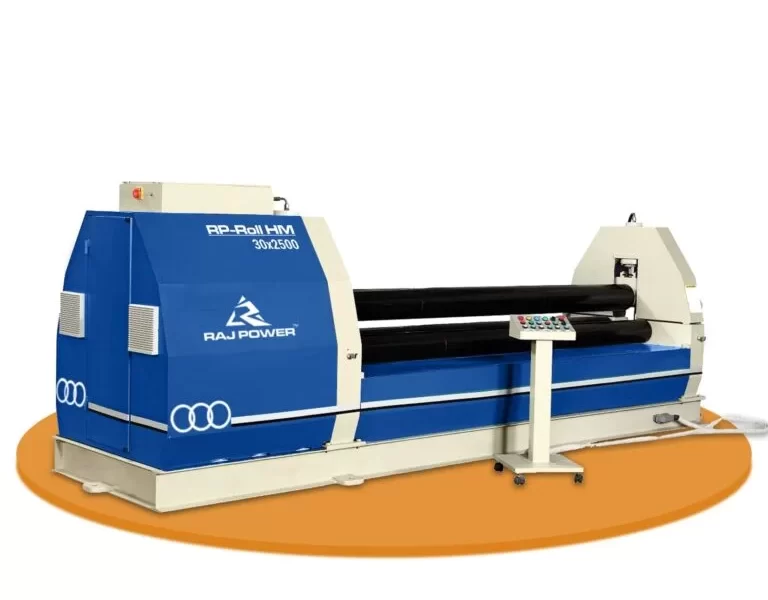
Plate rolling machines are a type of metal forming equipment that uses work rollers to generate sheet metal round processing and forming. Plate rolling machines are often referred to as plate bending rollers. This machine is a type of machine tool used for making continuous point metal sheet bending. The plate rolling machine is crucial in the sheet metal industry. This machine can be used to make cylindrical parts, conical parts, and various arc-shaped parts.
Plate Rolling Machine Operation Principle

- By using hydraulic oil in the cylinders working upon the piston, the upper roller of the symmetrical plate rolling machine accomplishes vertical movement at the center of two lower rollers. The main reducer’s final reduction gear drives the two lower roller gearing, generating a rotary motion that attempts to produce the torque required for the machine’s rolling of plates.
- The plastic sheet, which has now been flattened, is continually passed between the three work rollers, the two bottom rollers, and the upper roller of the rolling machine. The push of the higher rollers and the rotating motion of the bottom rollers combine to provide a continuous bending process.
- The center layer stays the same, and the outside layer stretches for deformation while the inner layer does compression deformation. The sheet metal workpiece suffers persistent plastic deformation due to the entire process. Finally, the metal sheet workpiece is rolled into a cylinder, cone, etc., based on the specifications.
- Large roll bending machines with a thickness of at least 50 mm are perfect for this plate rolling machine.
- The plate rolling machine’s lower roller is accompanied by a row of fixed steel rollers at its base in order to reduce the space between the two rollers, improve the finished product’s precision, and boost the machine’s overall performance and efficiency.
Plate Rolling Machine Classification
Various types of bending machines are available based on their different application sectors. Plate rolling machines are further divided into three-roller and four-roller variations depending on the number of rollers present. The following categories of three-roller bending machines include:
- Hydraulic bending machines.
- Arc downward-adjusting plate bending machines.
- Horizontal downward-adjusting three-roller bending machines.
- Symmetrical three-roller bending machines.
- Universal three-roller bending machines with an upper roller.
1. Mechanical
There are symmetrical and asymmetrical versions of the mechanical three-roller bending machine.
Mechanical symmetry three-roller
This machine is built with a three-roller, symmetrical frame. The machine’s upper roller rotates vertically in the center, symmetrically, with the two lower rollers. This configuration is achieved with the help of the worm and screw nut transmission. The rotational motion Transmission provides the needed amount of torque for the rolled metal plastic sheet in the machine via the output gear of the reducer meshing with the lower roller gear. The mechanical bending machine’s main drawback is the requirement to pre-bend the end of the sheet metal plate (with the aid of other equipment).
Mechanical asymmetrical three-roll
The three-roll asymmetrical design of this machine allows for the top roller to serve as the primary drive. In contrast, the lower roller moves vertically to hold the plate firmly and mesh with the upper roller gear through the lower roller gear.
2. Hydraulic
The ability to vertically elevate and lower the upper roller is the main advantage of the hydraulic three-roller symmetrical plate rolling/bending machine. This rolling machine’s vertical lifting hydraulic transmission is accomplished using hydraulic oil in the hydraulic cylinders operating on the piston rod. The output gear meshes via the machine’s reducer while the lower roller inside the machine is driven in rotation. A manually adjustable idler is positioned under the bottom roller to provide the appropriate torque for the coil.
This machine’s upper roller is structured like a drum, improving the product’s straightness and making it suited for producing extremely long tanks with various huge cross-sectional shapes. This machine can easily roll and shape metal sheets into circular, arc-shaped, and conical workpieces according to needs within a particular range since it is an upward-adjustable symmetrical three-roller plate rolling machine. Driving rollers make up one of the two lower rollers in this model, while driven rollers make up the other.
